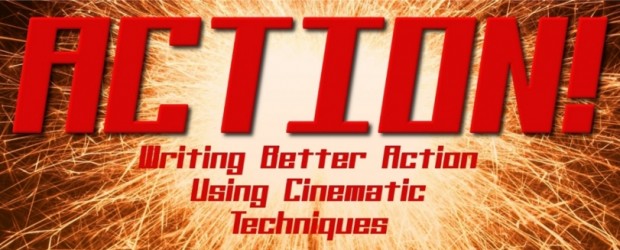Backstory: A space courier is refilling his spaceship when three thugs he’d seen the previous night appear on the landing pad demanding his cargo.
The Hunters split up, boxing him in. One donned brass knuckles; the other a switchblade.
Deep mentally rehearsed his moves. He pressed his foot against the base of the rig, waiting for the last moment. He had to move fast, without remorse. It was them or him. [This is good – you establish the character’s goal right away. Survival in the face of superior odds is a good basis for an action scene.]
Knuckles came in range. [I’ve noticed throughout this narrative that you have a lot of very short paragraphs. Unfortunately, I don’t think it works as well, because it breaks up the flow of what should be a smooth, well-paced fight scene. Every action doesn’t have to mean a new paragraph. I think if you were to consolidate these down, it would make your narrative read much better.]
Deep moved. [This 2-word sentence could be cut without hurting the narrative in the least. We know he moved, because you describe his motion very well in the next sentence.]
He lunged at the Wayfarer’s fuel port, ripped out the hose and sprayed it in Knuckles’ face.
Knuckles stumbled back, screaming, clawing at his eyes. Switchblade swung forward at Deep’s stomach.
Deep parried with the hose. The blade sizzled straight through. Pressurised fuel squirted out like a fountain, raining down on the pad.
Deep swung the hose nozzle at Switchblade, but Switchblade ducked and thrust his blade forward.
Deep fell back against the rig. [Try to change up the rhythm of your sentences. Five of the previous seven start with a character’s name, and three of those with Deep.] He grabbed the flow meter, rolled back onto the rig and kicked Switchblade in the face.
Switchblade’s head snapped back. His feet skidded in the fuel, but he managed to stay upright. [The previous six mini-paragraphs could be consolidated into a single paragraph. It would flow better and consists of what I term a single Stunt. If you think of this scene as a film director, the previous six paragraphs could be shot as a continuous take. When I’m writing a scene, I tend to think of paragraph breaks as new camera shots. When you see a movie that has action scenes broken up into lots of cuts, none lasting even as long as a second, do you find that it has no flow? I do. Same thing applies when writing one in fiction.]
Deep dropped back to a crouch and pulled the stiletto from his pocket. Them or me. [I like this little thought interjection.] He charged at Switchblade, slipped, fell forward and rammed the stiletto through Switchblades’ chest. [If you wanted to draw this out a little without hurting the pacing or flow, you could take all four of those clauses and give each one its own sentence. Longer sentences read faster than short ones, believe it or not, and sometimes readers blast through them so quickly they skip clauses (or forget and have to go back).] They fell together in a splash of fuel. Switchblade whimpered then lay still.
Deep hauled himself up—
Brass smashed into his side and a vice clamped his chest, squeezing him tight.
Pain rolled up his body like a tidal wave as he crashed to the ground, Knuckles holding him tight.
Deep clawed at the arms, but his hands were slippery from the fuel. Knuckle’s eyes were blood red, his face screwed up in rage.
Spots cluttered Deep’s vision. He couldn’t breathe. He smashed his elbows down on Knuckles’ head and back.
Knuckles kept squeezing. He battered at Deep with his knees. [I’m having a tough time picturing how this works. If you’re holding someone and squeezing them, even if you’re on the ground, you’re going to find it difficult to also knee people.]
Deep gasped as a rib cracked. He was beyond pain now though; he just kept crashing his elbows down again and again. Time had no meaning; all that existed was his arms and Knuckles.
Finally Knuckles grunted and his grip slackened.
Deep rolled away, gasping. Fuel thundered down from the heavens, deafening him, stinging his eyes. The switchblade lay by the rig. He dropped, fumbled, grabbed it, turned and slashed as Knuckles ran at him. [This is another four-clause sentence that could be split up. You’ve actually used an identical pattern as up above when Deep acts, missteps, acts, acts again.]
Knuckles’ stomach split open and he crashed to the ground.
Deep fell backward, chest heaving, fuel washing the blood from his hands.
The world darkened. The leader reared over Deep, pistol inches from his face. [I’m confused about who the leader is. Maybe you established that in the part coming up to the action scene. If you didn’t, you need to clearly identify who that is. Also, if he has a gun, why doesn’t he use it first?]
Fuel saturated every inch of the leader. It ran down his face, tracing the scars. He looked like a pieced-together monster. He spoke with a dark finality. “The ship fob.”
“Ok, ok,” Deep forced a shaking hand into his pocket and tossed the fob toward the ship. “Take her.”
The leader’s chuckle rang in Deep’s ears. “We’re way past that now, boy.” He jammed the pistol’s emitter into Deep’s forehead. “The human skull is a good flash suppressant.” He smiled.
[Overall you’ve got a good start to this scene. If I were rewriting it, I’d think in terms of Stunts. The first Stunt would be Deep defending himself against Switchblade and Knuckles. The second Stunt is Deep going on the offensive and stabbing Switchblade. The third Stunt is Knuckles on the offensive. The final Stunt is Deep turning the tables on Knuckles. Each of those Stunts could be a single paragraph. Thanks for submitting your scene!]
